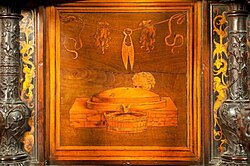Iacobi Catzii Silenus Alcibiades, sive Proteus- (1618) (14563024119)
Identifier: iacobicatziisile00cats (find matches)
Title: Iacobi Catzii ... Silenus Alcibiades, sive Proteus:
Year: 1618 (1610s)
Authors: Cats, Jacob, 1577-1660
Subjects: Emblems
Publisher: t'Amsterdam : By W. Blaeu
Contributing Library: University of Illinois Urbana-Champaign
Digitizing Sponsor: University of Illinois Urbana-Champaign
View Book Page: Book Viewer
About This Book: Catalog Entry
View All Images: All Images From Book
Click here to view book online to see this illustration in context in a browseable online version of this book.
Text Appearing Before Image:
s mijjchien een i-crucht)ft^/i? lang genough fd zjinghecrucht,Eer dan het l^tnt can Wef ngroot^S00 ü den ouden, ijader doot :Ofcrijghdy J^indsrs/oo vvat meer,Soofaetr/ien twij^ffèl aen u eer.Schoon t Clim den ouden hoorn be--pvafi^Hy ijpr doch niet mee gefafi ; (tonftjWant twtjl hem tCltm oi/iheI^9 enT>en dorren Ham fïaet als bedrouft^€n als de Chm op tfchoonslej^rujtyDan ^aet den ouden droogaert uyt. ^Male juncÏa fatijcunt. ANNA. SI qua tui tibi cura , Teni ne nube , puella,Ne jaceas viduo frigida nupta thoro.Si qua tibi veniet, veniet tibi poilhuma proies - Cuique negat cari mors genitoris opem.Autjfi fortè patri numerofior exftitit heres,Garrula quod de te fama loquarur habet.Labitur intereà teneri tibi Holculus arvi, Dumque gemis , vitx pars melioris abit.Cur hedera annofam complexibus implicat \lmum ? Vç milerx . perit haeCj cum magis illa viret.lila quidem ramos abit ambitiofa per omnes>At ficcis arbor (tat miferanda comis. MALE MALE IVNCTA FATISCVNT. XLI. ■ter:
Text Appearing After Image:
Vives liv. 1. de laFanm. Chrcft. I f^s a gouverner , c!r qiil ne fort aitfi (t ON doit avoir refpecf 4 laaçe , afin \ grand quUne pttijjc (nffre a gouverner,cjitilne fait moindre quileii requU A 1 laijfantvne femme veiifc chatgée des fe»vn pcrc de famille , qui a femme (j en- \ titscnfans orphelins. Kin- 84 KinderenHinderen. EnfandsTourmens. ANNA. G Een a>ipevpe?jaer met kinderstroutyTen zy, ghy (charnel zjjt of out :T)ie moeder vvert^noch ^^nde maegt^Ghemeenlijcl^ haer altijt beclaeght.Het Ù een dwcgants fvvaer om doen3Eens anders Zanders op te ijoen ;Hoe groot ghy -^n mooght yangedult^C^(och heeft de Hief-moer al defchult.En of den brujdgom al fijn bruytTet pooght te malden njooren uyt^eJls tot verge k <-van haer roer dr iet 3Den goeden man njerma^ het niet : Vyant^fchoon hji « Ipvel heeftgefnt^Ghy mooght maer diëten als een kint, Sooyemant op een jonghe siam£engrooientackje fnten quam.Met halfrvohvafènfreuyt helaenyDe vrucht verdrooght » en moet ver^ gaen,Oock^ Herft
Note About Images
Relevante Bilder
Relevante Artikel
Emblem (Kunstform)Das Emblem ist die komplexeste Kunstform der bildlichen und literarischen Sinnbildkunst. Entstanden in den 1520er Jahren in Italien, hatte die Emblemkunst (Emblematik) ihre Blütezeit in allein europäisch geprägten Kontexten bis Mitte des 18. Jahrhunderts. Als „das Herzstück der epochalen Sinnbildanschauungen“ war sie charakteristisch für das Medien- und Bildverständnis der europäischen Frühen Neuzeit insgesamt, das Bildern „Sprachbedeutung“ zuwies und die „Eigenleistung des Betrachters als Bestandteil der bildlichen Mitteilung“ vorsah. .. weiterlesen


































